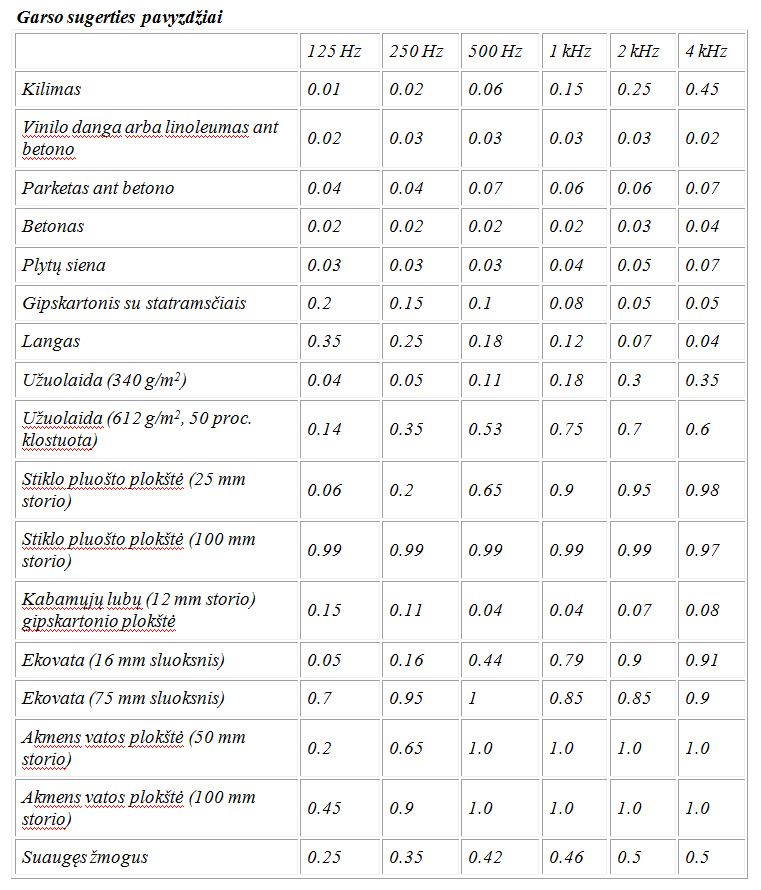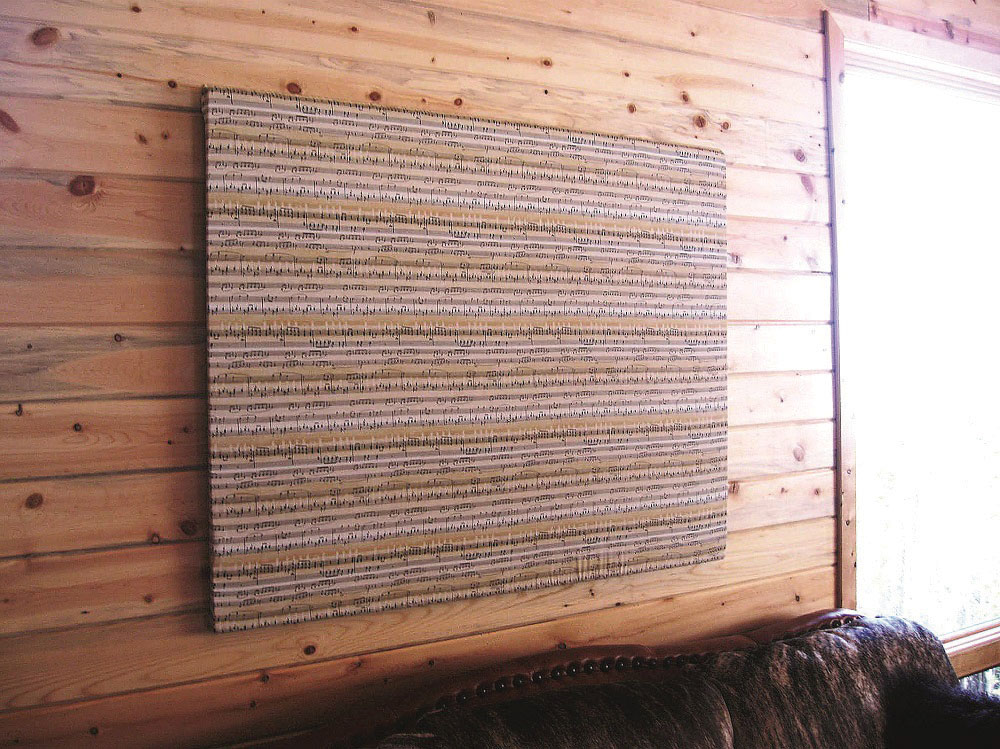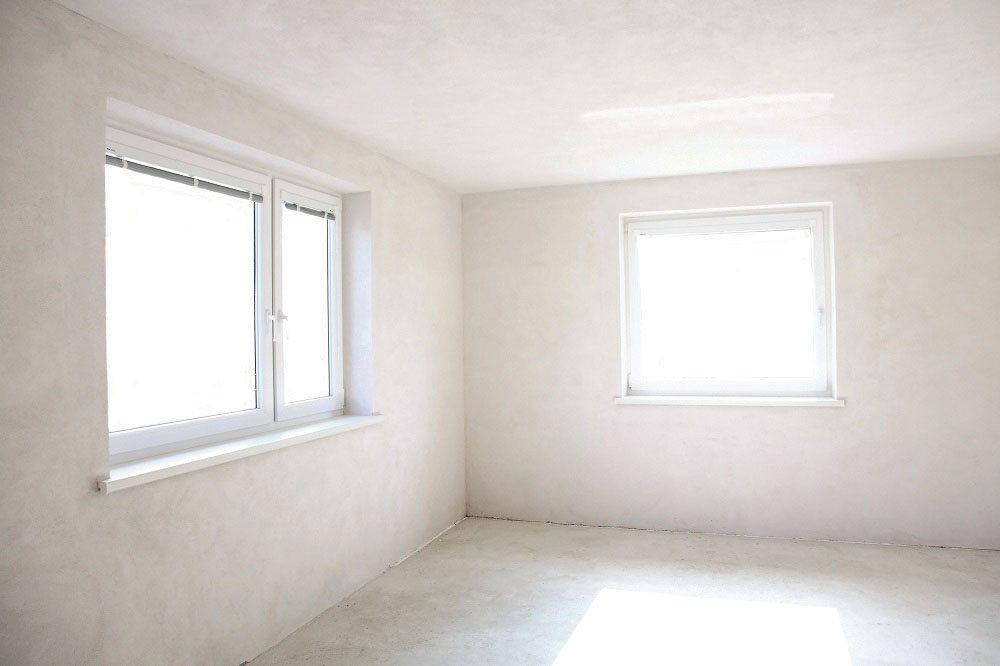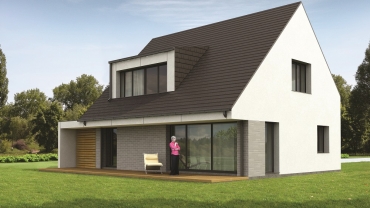
Swedish designers have created environmentally friendly, water-resistant, sound-absorbing wall coverings made of wood fiber and cement, which can be assembled like a jigsaw puzzle.
Aneta Vaitkienė
People comprehend comfort of living environment with all the senses, including hearing. Two necessary acoustic comfort conditions - efficient room sound insulation and good interior acoustics. Although these factors are very often confused and thought of as the same feature, in fact, they are two completely different concepts.
No matter how well insulated from the external noise the premises are, interior acoustic problems may remain unsolved. A person must feel comfortable in the room, not to hear the extraneous noise and resonating sounds but the acoustic comfort is still considered a luxury and a secondary matter.

Acoustic Materials. Being fibrous or perforated structures, the acoustic material absorbs sound, reduces background noise and improves sound intelligibility. Their raw material - wood fiber, rock wool, glass wool, synthetic fibers. Surfaces of such materials are treated with special porous breathable paint or covered with air conductive or non-woven materials. The fibrous material has a soft, porous structure and relatively high aerodynamic resistance. A part of the sound energy passing through the material due to friction between the air particles and pore transforms into thermal energy.
At home, we are surrounded by several sources of sounds. First, it is transmitted by the sound source (direct) sound emitted by a person, audio, video and home appliances and so on. Second, the sound reflected from the surface of the room (sound reflections). It depends directly on the decorative materials of interior and their layout geometry. Sound wave like a ball bounces off the surface and after fluttering around the room is stuck in the surface and damped. The acoustic comfort of the room depends on how the sound in the room is reflected or absorbed. If the indoor surface reflects sound too good, an echo effect forms and you might feel like being in an iron barrel. If the sound is too absorbed, you will lose the sense of space, you will feel like having stuffy ears.

Resonant materials. They are solid, with a certain pattern perforation (holes network). They operate on the principle Helmholtz resonator indoor air volume behind panels with space is linked through a narrow neck. By hitting the plate, wave increases the pressure in the inner volume, and the next sound wave deforms at the neck outlet. The energy is absorbed by the friction of the neck. Resonant material absorbs the sound close to resonant frequency. Their effect depends on the type and percent of perforation, hole size, the plate thickness and volume behind the material.
Important figures
The human ear can hear 16-20 000 Hz frequency sounds:
• 16-350 Hz - low frequency;
• 350-800 Hz - medium frequency;
• 800-20000 Hz - high frequency.
Low frequency sounds of the same strength are heard worse than a moderate or high frequency sounds. We are almost unable to hear sounds less than 40 Hz but they are often physically felt as a vibration.
Human language fits into the 100-7000 Hz frequency range, it is both high and low frequency sounds.

The carpet, upholstered furniture, drapes, sound waves and braking and dissolving uneven wall decorations - all this eliminates undesired echo.
Extinguishers of sound reflections
Ceilings - is the largest free space in the room, from which the sound is reflected and returning echo. On the floor and by the walls in the room are all kinds of things - furniture, carpets, cushions, paintings and so on. The sound already has where to deafen or disintegrate and the ceiling is usually smooth and uncovered. Thus, the change of their acoustic properties can make the most impact.
 Only the thick and dense fabric curtain may well absorb the sound waves.
Only the thick and dense fabric curtain may well absorb the sound waves.
Victor Mekas, acoustics engineer at JSC “Architecture. Acoustics. Technology” suggests to install suspended ceiling from acoustic materials and to hang in most “sounding" places the material segment on the wall. 2-4 cm thick fibrous material absorbs medium and high frequencies (α coefficient from 0.4 to 1.0) and more than 4 cm - and a certain low-frequency level.
"Acoustic resonance plates can be mounted not only on the ceiling but also on the walls. Most importantly, the product has to be distanced from the wall at least 2 cm, otherwise, the effect will not occur"- says V. Mekas.
Carpet on the floor can also absorb sound waves. A thick carpet of 1 cm with underlay absorbs high-frequency sound, which we subjectively perceive as noisier than the low frequency. Thus, the carpet can be a part of sound absorbing solutions complex. In addition, soft flooring eliminates the intrusive noise of walking: your neighbors will be grateful for such a decision because they will no longer have to suffer from the noise created of your walking, falling objects or vacuum cleaner.

Interior designers at New Harley Davidson headquarters in Neu-Isenberg (Germany), in accordance with the provision "born to be wild, but not too noisy”, installed sound-absorbent acoustic panels in the ceiling.
The sound absorption coefficient α
This is a dimension, which indicates material's ability to absorb different frequency sounds. α varies from 0 (total reflection) to 1.00 (full absorption).

Carpets, successfully absorbing high-frequency sounds, however, are not able to cope with the low-frequency sounds. "Most of the domestic sound-absorbing materials successfully reduce the noise of high and partly medium frequencies, while the low frequencies always are the biggest problem - shared his experience Mr. Mekas. – Typically, membrane structures are used to extinguish the low frequencies (when there is no need to additionally absorb medium and high-frequency sounds), which vibrates throughout the entire surface. Membrane absorber - is a solid plate with an airtight space behind it. This gap may be filled with a porous material such as Rockwool. However, if you need to absorb the wider spectrum of frequencies, we always recommend using a fibrous or resonant material, distanced from the hard surfaces. Their installation close to the corners of the room further reduces low-frequency problem.
• One of the examples of membrane materials - double drywall partitions. In a space, equipped with such structures, the low male voice will echo less and high female voice resounding will alter slightly.
• The window glass is also a membrane absorbing low frequencies but reflecting high ones. So, it can be said that the carpet and a window are in tune with each other and complement each other.
• High-frequency sound waves are slightly absorbed by the window curtains but their density and thickness are not sufficient to make an impact. "If the curtain is dense and has pleats, it, of course, will improve the sound absorption but the guests wearing thicker coats will be more useful," - cheerfully compared V. Mekas.
All parts of echo effect extinguishing complex - rough wall decorations, household items, textiles, upholstered furniture, curtains - absorb or break down sound waves but their effect on a smaller surface area and poor sound absorption compared with the ceiling or the floor is not significant. On the other hand, all these small instruments form a whole, in any case, using them is better than doing nothing.
• For example, a bookcase mounted on the wall will do some sound absorption. If the books are lined up unevenly, their backs will form a messy surface in to which acoustic waves will break and disperse.
• If you hang a painting on the wall, its sound absorption will be minimal. If you distance it a little bit off the wall and insert a porous acoustic material plate into the gap, the effect will increase.
• "An even greater effect can be achieved by proper positioning of "acoustic images" or bookcases. Just take some time and try altering the furnishings, then stop and listen to the sound of the room"- suggested Mr.Mekas.


You can produce the acoustic panels by yourself, by coating mineral wool strip with a cloth and hanging it on the wall. Or you can go to the designers, who will propose a prefabricated wall decoration modules from recycled materials - fabrics and plastics.
Sound reflection duplicators
Materials with sound absorption coefficient α close to 0, reflect the sound waves. For example, concrete or polished stone sound absorption of almost every frequency noise is minimal. Sound waves are reflected from such surfaces almost without loss and are spreading further until they bump into anything else. Now, imagine two parallel concrete, even walls and a man standing in-between. If he smacks his palms and you will get a nearly infinite echo.
In general, it can be said that all non-porous, solid constructions with a smooth surface and the circuit has no broken edges that are parallel to or merged in steep/acute angle, create standing waves or echo. The harder surfaces are in the room (floor tiles, parquet floors, bare walls, etc.) and the less furniture, the more everything will echo, and vice versa - the softer surfaces (carpets, curtains, upholstered furniture, beds and so on.) or surfaces that break down audio front, the less echo there will be.

Did you know that if you speak on the phone in the room where all surfaces are solid, (glass walls, windows, shop windows, laminate flooring, concrete ceilings), voice echo reverberating from such surfaces, can return to your ears up to 16 times? Under these conditions, a person within a few hours will get tired of his own voice echo without even noticing it. A headache or even nausea may occur. What if in such room dozens of people communicate with each other at the same time?
When the echo begins to be harmful?
Reverberation (echo) duration - this is the time of seconds it takes for the sonorous sound to weaken in a closed room to one-millionth part of the initial intensity. In small enclosed spaces, living rooms the reverberation time can take up to 1 second. The is longer the reverberation is, the more exhausting it will be to a person. Acceptable reverberation time is 0.9 - 1.0 s, the comfortable is 0.4-0.6. If this time is less than 0.4 s, the room seems to be "dead", if the sound is not amplified, communication can become uncomfortable. It is not possible to accurately measure the reverberation time with household tools, which requires a special device – sound level meter which is normally used by professional acoustics. However, the estimated reverberation time can be tested by using a special computer with a microphone or smartphone apps.



